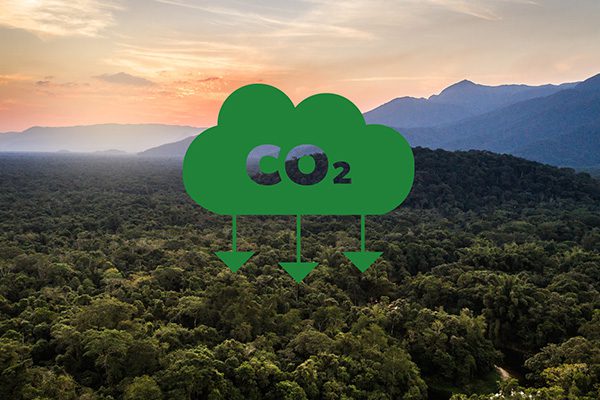Energy Earthshot: Fueling The Clean Energy Transition
By Noelle Toumey Reetz
By Noelle Toumey Reetz
Imagine a fuel source that is created by turning carbon dioxide from the environment into an energy source to power our lives. That is one of the bold aims of the new Energy EarthshotsTM initiative funded by the U.S. Department of Energy (DOE).
It’s also one of the major global challenges facing researchers—how to reduce the existing carbon dioxide (C02) in the atmosphere and transform it into useful compounds or even clean fuels.
So far, the process of transforming CO2 into more valuable and environment-friendly molecules has been costly and energy intensive, but researchers believe advances could provide a crucial step forward in renewable energy technology. Thanks to a three-year, $3 million project, Georgia State will lead one of 18 university Scientific Foundations for Earthshots research teams.

Georgia State professor of Chemistry Gangli Wang is leading a multi-institutional team of interdisciplinary scientists to develop new electrocatalysts which could be carbon ‘negative’ by removing environmental CO2 using nanoelectrochemistry and to produce hydrogen through water electrolysis. The research will focus in two of the Earthshot areas: the Hydrogen Shot and the Carbon Negative Shot.
Wang says a breakthrough could provide a huge impact for climate change if CO2 could be reduced or converted to a usable fuel.
“We aim to tackle the challenge of generating suitable form of energy while meeting different needs for better quality of life, and reducing our impact on the environment,” Wang explained.
Georgia State is one of the 18 universities across the U.S. to establish research teams as part of the overall $264 million Earthshots initiative.

Developing Catalysts
The grant “Atomic Level Compositional Complexity for Electrocatalysis (Atomic-C2E)” brings together scientists from across the U.S. to focus on providing energy or fuels more efficiently while lowering environmental impacts by understanding the bottleneck reactions at the atomic level.
“Our two-pronged approach aims to develop these two types of new materials that will serve as electrocatalysts for carbon dioxide reduction and water splitting,” explains Wang. “First, we are working to develop high entropy oxides, or HEOs. We are also developing atomically precise metal nanoclusters, known as APNCs.”
Wang says that both HEOs and APNCs are already showing promise. These include copper and bimetallic Cu-Au nanoclusters for highly efficient CO2 reduction into valuable products such as ethanol that could be used as fuel sources.
The researchers explain that in terms of chemical compositions and atomic structures, most other electrocatalysts lack some of the essential properties required to make them successful. Manju P. Maman, a postdoctoral scholar working with Assistant Professor of Chemistry Xuefei Li, explains that “hot spots” is a term used to suppose an active site for the catalytic reaction where the atomic structure is unknown. This work will help narrow down those unknowns.
“The properties of these materials can be better understood through computational simulations. The team of computational scientists included on this project will tackle these unique challenges using a range of different theories and methodologies,” said Samer Gozem, associate professor of Chemistry.
According to the NOAA, carbon dioxide in the atmosphere has increased 100 times faster in the past 60 years than it did during the end of the last ice age.
Georgia State’s team includes four faculty researchers, post-doctoral researchers and students in their research groups who are working to synthesize catalysts, characterize their performance and develop theoretical models.
Associate Professor of Geosciences and Associate Dean of The Graduate School Nadine Kabengi is one of Georgia State’s faculty researchers who will lead the effort toward student success in addition to research.
“We are excited for members of this stellar Georgia State team to be recognized as major players and contributors to the much needed scientific breakthroughs in support of advancing clean energy technologies and the Energy Earthshots initiative,” Kabengi said. “We are even more excited for the attention and care the whole team, at Georgia State and collaborating institutions, has given to ensuring all students and postdocs are engaged in all aspects of the project. It is an explicit commitment to recognizing the significance of diverse perspectives and voices in addressing future societal challenges.”
The project will offer opportunities for graduate and undergraduate students and post-doctoral scholars to perform cutting-edge research while gaining valuable experience.
“Engaging in such projects exposes me to diverse fields and fosters both skill development and knowledge advancement, which are invaluable for my personal growth and professional development,” said Ruoyu Yang, from Wang’s lab on Georgia State’s Atlanta Campus. “I am particularly excited about the potential of nanopipette-based imaging of reactions catalyzed by the single entities with atomic precisions, as they offer novel pathways for understanding matters at the nanoscale more effectively.”
The research team includes experts from several universities and institutions, including: Georgia Tech, Carnegie Mellon University, the University of Utah and the Oak Ridge National Laboratory. Wang says it takes this level of collaboration from experts across scientific areas to develop groundbreaking solutions.

At The Atomic Level
The researchers say that in order to reduce CO2 into high value products such as ethanol, multiple steps of reactions need to occur in tandem. Those reaction steps involve the breakage and formation of chemical bonds — atom rearrangement associated with electron transfer reactions. Wang says understanding and controls at atomic levels will be crucial to improving the specificity and efficiency.
“Georgia State is proud to be a university working to develop solutions for the Energy Earthshots initiative,” says Interim Vice President of Research and Economic Development Donald Hamelberg. “Our researchers are making an impact in areas that are critical to solving some of the most challenging environmental problems.”
In a press release, U.S. Secretary of Energy Jennifer M. Granholm reiterated the importance of academic research to find game-changing solutions.
“The Energy Earthshot Research Centers and the related work happening on college campuses around the country will be instrumental in developing the clean energy and decarbonization solutions we need to establish a 100% clean grid and beat climate change,” Granholm said.
The Research Team
Gangli Wang, Georgia State University
Samer Gozem, Georgia State University
Nadine Kabengi, Georgia State University
Xuefei Li, Georgia State University
Rongchao Jin, Carnegie Mellon University
Guoxiang Hu, Georgia Institute of Technology
Sheng Dai, Oak Ridge National Laboratory
Zac Ward, Oak Ridge National Laboratory
Valeria Molinero, University of Utah
Henry White, University of Utah
For more information about Georgia State Research, visit research.gsu.edu.












Leave a Reply